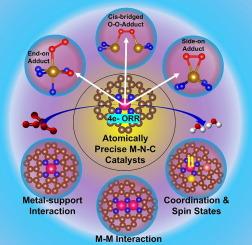Atomically precise M-N-C electrocatalysts for oxygen reduction: Effects of inter-site distance, metal–metal interaction, coordination environment, and spin states
IF 13.1
1区 化学
Q1 Energy
引用次数: 0
Abstract
Inspired by molecular catalysts, researchers developed atomically precise nitrogen-coordinated single or dual metal sites imbedded in graphitized carbon (M-N-C) to fully utilize metallic sites for O2 activation. These catalysts performed remarkably well in the electrocatalytic oxygen reduction reaction (ORR) due to their distinct coordination and electrical structures. Nonetheless, their maximum efficacy in practical applications has yet to be achieved. This agenda identifies tailoring the coordination environment, spin states, intersite distance, and metal–metal interaction as innovative approaches to regulate the ORR performance of these catalysts. However, it is necessary to undertake a precise assessment of these methodologies and the knowledge obtained to be implemented in the design of future M-N-C catalysts for ORR. Therefore, this review aims to analyze recent progress in M-N-C ORR catalysts, emphasizing their innovative engineering with aspects such as alteration in intersite distance, metal–metal interaction, coordination environment, and spin states. Additionally, we critically discuss how to logically monitor the atomic structure, local coordination, spin, and electronic states of M-N-C catalysts to modulate their ORR activity. We have also highlighted the challenges associated with M-N-C catalysts and proposed suggestions for their future design and fabrication.

用于氧还原的原子精确 M-N-C 电催化剂:位间距、金属-金属相互作用、配位环境和自旋态的影响
受分子催化剂的启发,研究人员开发了原子精确的氮配位单金属位或双金属位嵌入石墨化碳(M-N-C),以充分利用金属位激活氧气。由于其独特的配位和电结构,这些催化剂在电催化氧还原反应(ORR)中表现出色。然而,它们在实际应用中的最大功效仍有待实现。本议程将调整配位环境、自旋态、位间距离和金属-金属相互作用作为调节这些催化剂 ORR 性能的创新方法。然而,有必要对这些方法和所获得的知识进行精确评估,以便在未来设计用于 ORR 的 M-N-C 催化剂时加以应用。因此,本综述旨在分析 M-N-C ORR 催化剂的最新进展,强调其在改变位间距离、金属-金属相互作用、配位环境和自旋状态等方面的创新工程。此外,我们还认真讨论了如何对 M-N-C 催化剂的原子结构、局部配位、自旋和电子状态进行逻辑监控,以调节其 ORR 活性。我们还强调了与 M-N-C 催化剂相关的挑战,并对其未来的设计和制造提出了建议。
本文章由计算机程序翻译,如有差异,请以英文原文为准。
求助全文
约1分钟内获得全文
求助全文
来源期刊

Journal of Energy Chemistry
CHEMISTRY, APPLIED-CHEMISTRY, PHYSICAL
CiteScore
19.10
自引率
8.40%
发文量
3631
审稿时长
15 days
期刊介绍:
The Journal of Energy Chemistry, the official publication of Science Press and the Dalian Institute of Chemical Physics, Chinese Academy of Sciences, serves as a platform for reporting creative research and innovative applications in energy chemistry. It mainly reports on creative researches and innovative applications of chemical conversions of fossil energy, carbon dioxide, electrochemical energy and hydrogen energy, as well as the conversions of biomass and solar energy related with chemical issues to promote academic exchanges in the field of energy chemistry and to accelerate the exploration, research and development of energy science and technologies.
This journal focuses on original research papers covering various topics within energy chemistry worldwide, including:
Optimized utilization of fossil energy
Hydrogen energy
Conversion and storage of electrochemical energy
Capture, storage, and chemical conversion of carbon dioxide
Materials and nanotechnologies for energy conversion and storage
Chemistry in biomass conversion
Chemistry in the utilization of solar energy
 求助内容:
求助内容: 应助结果提醒方式:
应助结果提醒方式:


